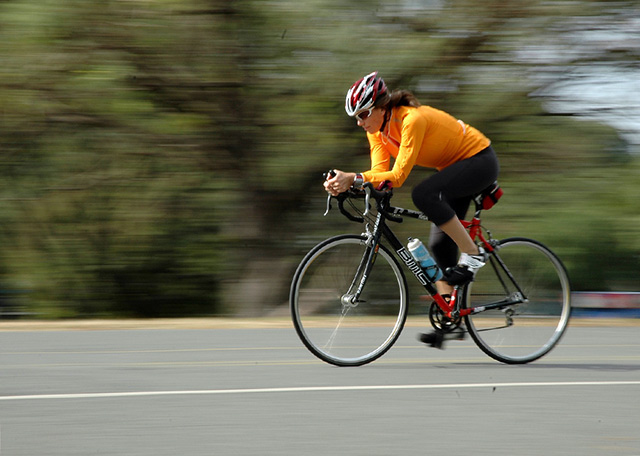The 12-Minute Cycle Test (Cooper, 1982) is an aerobic fitness test, in which the participants attempt to cover as much distance as possible in 12 minutes. This is the cycling version of the Cooper 12-minute walk/run test. There is also a swimming version. The test requires proficiency in cycling technique in order to adequately estimate aerobic fitness. This test is conducted while riding a bicycle. There is also a version on an exercise bike, the 12-Minute Stationary Cycle Ergometer Test (Vanderburgh, 1993). See other cycling fitness tests.
test purpose: This test measures aerobic fitness and leg muscles endurance, as well as cycling technique.
equipment required: An appropriate cycling route (e.g. a road or velodrome), bicycle, stopwatch. If a velodrome track is not used, it is preferable to have an out and back course to account for the effect of wind. If GPS trackers are used a more accurate measure of distance can be gathered.
pre-test: Explain the test procedures to the subject. Perform screening of health risks and obtain informed consent. Prepare forms and record basic subject information such as age, height, body weight, gender. Record the test conditions, such as the weather, wind and track surface, particularly if testing is performed outside. Record details of the bike used, and set up the seat and handlebars to suit the athlete. See more details of pre-test procedures.
procedure: Using a bike of their choice, the subject is required to cover as much distance as possible in 12 minutes. The participant starts from a stationary start with their feet on the pedals with a person holding onto the subject. Begin on the signal ‘ready, start’. The tester should start the stopwatch as soon as they say ‘start’. The cyclist may use any combination of gears and cadences to achieve the furtherest distance. The participant stops cycling when 12 minutes has been elapsed, and the total distance completed is recorded.

scoring: The total distance is recorded for each participant, to the nearest 10 meters. Recording the bike details is also important if you wish to repeat the test or compare to other results.
ratings:
TABLE: 12-minute Bicycle Test ratings for MALES. Distance in miles for different age groups
| 13-19 | 20-29 | 30-39 | 40-49 | 50-59 | 60+ | |
|---|---|---|---|---|---|---|
| Excellent | >5.75 | >5.5 | >5.25 | >5.0 | >4.5 | >4.0 |
| Good | 4.75-5.74 | 4.5-5.49 | 4.25-5.24 | 4.0-4.99 | 3.50-4.49 | 3.0-3.99 |
| Fair | 3.75-4.74 | 3.5-4.49 | 3.25-4.24 | 3.0-3.99 | 2.50-3.49 | 2.25-2.99 |
| Poor | 2.75-3.74 | 2.5-3.49 | 2.25-3.24 | 2.0-2.99 | 1.75-2.49 | 1.75-2.24 |
| Very Poor | <2.75 | <2.5 | <2.25 | <2.0 | <1.75 | <1.75 |
source: Cooper (1982)
TABLE: 12-minute Bicycle Test ratings for FEMALES. Distance in miles for different age groups
| 13-19 | 20-29 | 30-39 | 40-49 | 50-59 | 60+ | |
|---|---|---|---|---|---|---|
| Excellent | >4.75 | >4.5 | >4.25 | >4.0 | >3.5 | >3.0 |
| Good | 3.75-4.74 | 3.5-4.49 | 3.25-4.24 | 3.0-3.99 | 2.50-3.49 | 2.0-2.99 |
| Fair | 2.75-3.74 | 2.5-3.49 | 2.25-3.24 | 2.0-2.99 | 1.50-2.49 | 1.25-1.99 |
| Poor | 1.75-2.74 | 1.5-2.49 | 1.25-2.24 | 1.0-1.99 | 0.75-1.49 | 0.75-1.24 |
| Very Poor | <1.75 | <1.5 | <1.25 | <1.0 | <0.75 | <0.75 |
source: Cooper (1982)
advantages: large groups of athletes can be tested at once, and it is a very cheap and simple test to perform if all the participants have bikes to use. If the test is conducted on a velodrome track, all the athletes will be in view throughout the test
disadvantages: Practice and good pacing are required, and performance on this test can be affected greatly by motivation. If cycling around a velodrome track, you will be able to provide continual feedback on the time to help with pacing.
variations: There is also a 12-Minute Stationary Cycle Ergometer Test (Vanderburgh, 1993), rather than riding on a track or road.
references:
- Cooper, K. H. 1982. The Aerobics Program for Total Well-Being. New York: Bantam Books.
- Vanderburgh, P. M. (1993). The 12-Minute Stationary Cycle Ergometer Test: An Efficacious VO2peak Prediction Test for the Injured, Journal of Sport Rehabilitation, 2(3), 189-195.
- Vanderburgh, P. M., & DeMeersman, R. E. (1993). Validation of the 12-Minute Cycle Ergometer Test Using a Higher Resistance Setting, Journal of Sport Rehabilitation, 2(4), 268-273.
- Vanderburgh, P. M. (1995) An Improved 12-Minute Cycle Ergometer Test, Journal of Strength and Conditioning Research: p 261-263
Similar Tests
- Cycle 2km — 2 kilometer bicycle time trial
- The 5km cycle ergometer test
- Cooper 12-minute walk/run test
- Swim 12-minute test — swim for maximum distance in 12 minutes
- Wheelchair 12-minute Aerobic Test
Related Pages
- Fitness tests for cyclists
- Cycling Fitness Tests — assessments involving cycling exercise
- Comparison of Cycle Ergometers
- Other aerobic fitness tests


 Current Events
Current Events